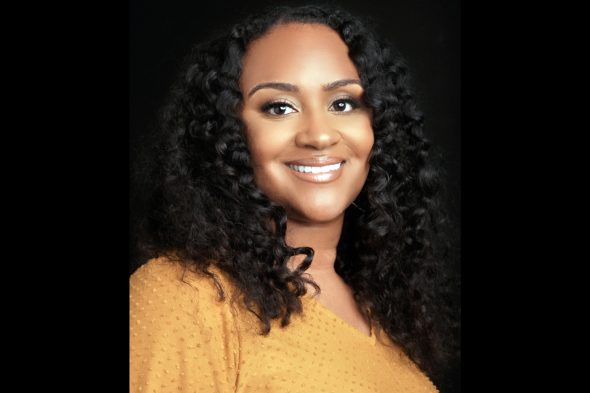UIC professor honored for teaching how to search for joy in classroom lessons

Even as a young child in Gary, Indiana, University of Illinois Chicago alumna Gholnecsar “Gholdy” Muhammad knew she wanted to be a teacher and would gather other children and her older brother before her in a make-believe classroom and begin teaching.
“I have always wanted to be a teacher, ever since I can remember, from playing school with my older brother to writing curricula — I didn’t call it curricula then but when I was a child I would create learning experiences for all of the other kids in the neighborhood,” Muhammad said. “That’s what I do now. I write curricula — I write experiences and stories to tell and to teach.”
Muhammad returned to UIC this fall as an associate professor of literacy, language and culture in the College of Education, where she earned her doctorate in literacy, language and culture in 2013. Prior to joining UIC, she was a professor at Georgia State University, where she helped set up a program to train teachers in South Africa.
Recently she was the recipient of the 2021 Outstanding Educator in English Language Arts Award from the National Council of Teachers of English.
She was honored for her nearly 20 years in the educational field, which includes serving as a middle school language arts and social studies teacher in southern Illinois, where she coached teachers and served as a literacy curriculum specialist. Later she served as a school board president in another state.
As a UIC student, Muhammad founded a summer writing institute called Black Girls W.R.I.T.E. to give young Black girls a space to “read, think and write about racial and other social injustices.” It was also a space to write about Black girl beauty and joy, she said. The idea came to her as she finished the first year of her doctoral program at UIC.
She is the author of the bestselling book “Cultivating Genius: An Equity Model for Culturally and Historically Responsive Literacy,” published in 2020.
Among her topics of interest is giving a historical context to how education is shared and the role that literacy plays. She pointed to examples in curricula and textbooks that haven’t moved out of the 1800s.
“The biggest problem to me in education is that there is a lack of culturally responsive education and a lack of rigor,” Muhammad said. “We mostly teach skills that are decontextualized to the world and children’s lives and we were doing that in the 1800s. We’re not giving students all of what they need and deserve.”
Her book and research have shown her that while often educators are so focused on preparing students for tests, they are not preparing the students for “life, wellness and joy.”
From this research, she developed the HILL model to respond to students’ “Histories, Identities, Literacies and Liberation.”
As part of this idea, she developed five pursuits for learning: Identity development, Skill development, Intellectualism, Criticality and Joy:
- Identity development relates to helping students develop a firm grasp of who they are so that they can learn about others outside of themselves.
- Skill development emphasizes mastery of skills so that they can be translatable to other topics.
- Intellectualism is being able to take content and translate them into concepts that apply to life.
- Criticality asks: How is my instruction helping students to name, interrogate and disrupt inequities, justice, power, pain, marginalization, exploitation and misrepresentation against myself and others?
- Joy asks: How am I elevating beauty and humanity?
Most recently, her model has been supported by artists, including musician Pharrell Williams, who has adopted it for his new school, and textile artist Bisa Butler, whose exhibit is currently at the Art Institute of Chicago, as well as others.
She is also working to integrate the curricula at Waubonsie Valley High School, her alma mater. While working with teachers at her former school, she learned that many of the learning practices they were using had not progressed since she left the school more than two decades ago.
“We had to have very hard conversations about how not to have another 20 years doing the same things that are not helping children,” Muhammad said.
She commends the district for realizing it was time to update itself and remembered when, as she was a child, her family moved from Gary to the Chicago suburbs. She left a school where she felt warmth and connections with others.
“When I moved to the suburbs, I didn’t have that. I didn’t see a teacher who looked like me. I didn’t see a teacher who helped me to learn, ‘who I am,’” she said.
She credits her teachers in Gary’s Banneker Elementary School for instilling a love of learning and a love for herself. She emphasizes in her writing and teaching how a single teacher who can instill a sense of self and self-love can play a dramatic role in people’s lives. She said the aim of her work is to get teachers and curricula to understand the important roles they play.
“I would look at my teachers and I wanted to do that. The teachers were my stars,” she said. “It just felt like this is what I was supposed to do.”
She had a similar feeling when she looked at how UIC played a pivotal role in her life. She said returning to Chicago, where her family still lives and returning to the university itself, seemed a natural progression for her.
“I’ve always felt like I’m supposed to be back at UIC because I’ve always felt that this is home,” Muhammad said. “I loved the type of education I received, the faculty and the department at UIC in the College of Education. I’m happy to be a part of that.”
